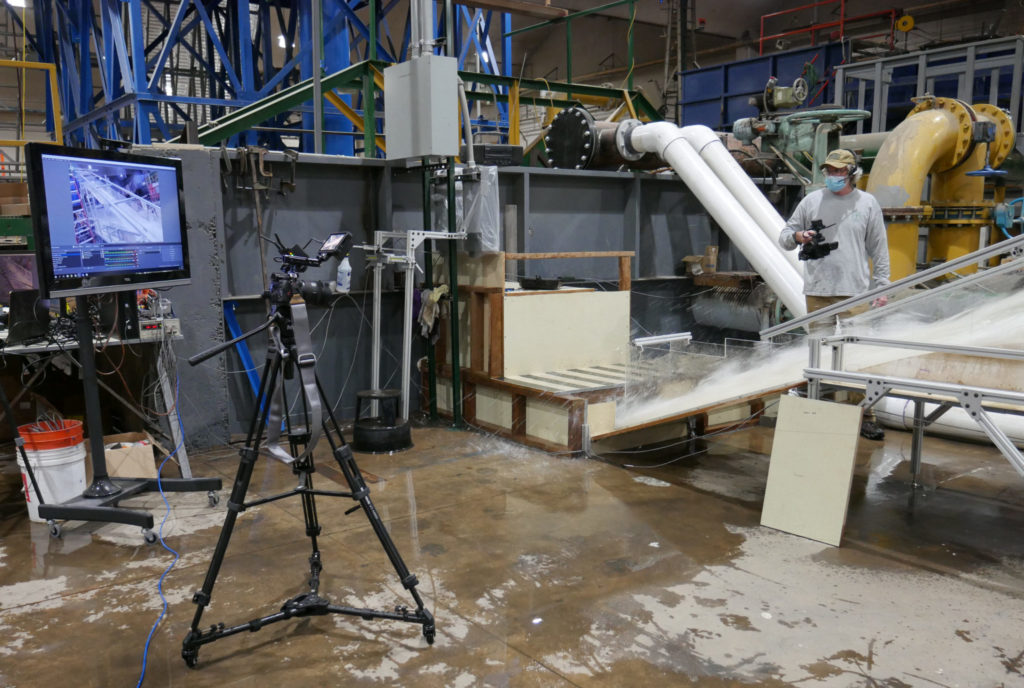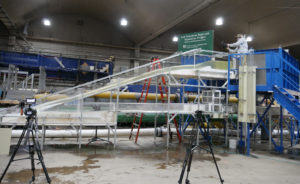
The pandemic hasn’t stilled Colorado State University’s Hydraulics Lab, though it has cut down on the number of people working on projects there and slowed their pace a bit. The water keeps flowing, and the state-of-the-art lab continues to provide valuable hands-on education as well as advancements in hydraulics engineering.
On a recent afternoon, a small team led by Associate Professor Chris Thornton demonstrated their newly constructed model of the Los Vaqueros Dam spillway and emergency outlet for stakeholders in California and Denver. Normally, clients such as these would visit in person to see the model in action, but the COVID era has forced their meeting online.
Joining the CSU team via livestream were officials from AECOM, the Contra Costa Water District and the California Department of Water Resources. AECOM, a multinational engineering firm, hired Thornton and the lab to build a 1:12 scale model and test the firm’s design for raising the Los Vaqueros Dam in northeastern California.
The Contra Costa Water District commissioned the renovation to raise the dam 58 feet and expand its holding capacity by 70 percent. A feasibility report projects the renovation will cost $900 million. The Los Vaqueros Reservoir secured by the dam supplies drinking water to more than 600,000 customers.
“Engineering and design complexities require construction and testing of a physical model to ensure performance and system safety of the spillway and sluice outlet,” said Thornton, who also directs the Hydraulics Lab.
The spillway will allow for the controlled release of water from the reservoir. The sluice outlet, an emergency bypass of the spillway, is a fairly unusual feature, used in only a handful of new dam projects so far. The sluice outlet will be built inside the dam and is designed to release water from the reservoir quickly in the event of an emergency. The target release rate is 3,000 cubic feet per second, or roughly 30 times the current rate of the Poudre River.
Construction on the model began in the spring and was completed in September. Civil engineering graduate student Cody Volt and research associate and lab manager Taylor Hogan built the model from their AutoCAD design to physical construction. Now they are overseeing its testing.
“We’ve identified some issues that we didn’t foresee, which is the whole idea,” Volt said. “It’s really cheap to work out these design flaws now, versus the real thing, which costs millions of dollars. We like to say it’s cheap insurance.”
This isn’t the first time AECOM has asked Thornton and the Hydraulics Lab to vet one of their designs. Last year the CSU team constructed a model of the Gross Dam spillway for AECOM’s project with Denver Water.
Physical models are needed to validate computer models, Volt said, and there are some areas in which computer models fall short. One of those is in predicting the behavior of aerated water. It’s an issue the CSU team has observed in the Los Vaqueros model and will work to smooth out, so AECOM can adjust their specifications.
Thornton points out the issue to stakeholders during the virtual meeting, as he walks around with a video camera giving the remote viewers a close-up tour. If they were physically present, they would feel the spray and have to shout over the roar from the model, but they can hear Thornton and the team clearly over the headsets the CSU team also uses to communicate with one another in the lab.
With millions of dollars not to mention lives downstream of the dam at stake, all the participants involved in the project want to verify the structures’ safety before construction on the real thing begins.
“There’s so many people living downstream, there’s no room for error. It’s got to be right the first time,” Volt said.

Testing will continue through June. The CSU team also includes Professor Rob Ettema, student employee Jeff Ellis and two to three undergraduate students who assist when needed.
“Studies like the Los Vaqueros project not only provide critical information to engineers and designers, but the ability of our students to contribute and gain a working knowledge of this aspect if civil engineering is invaluable,” Thornton said.